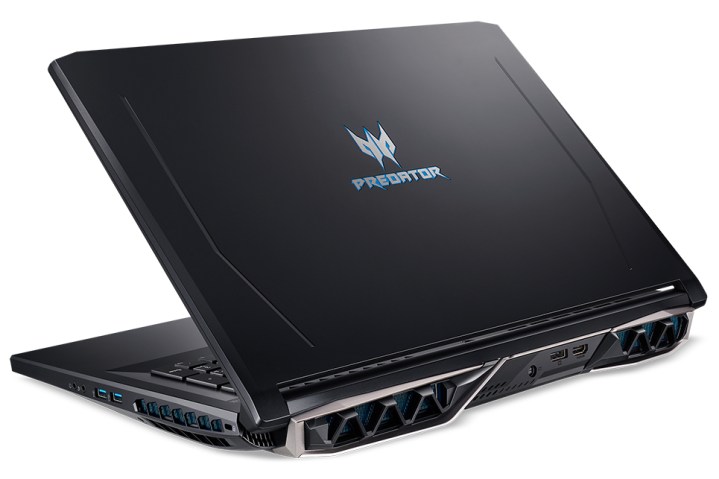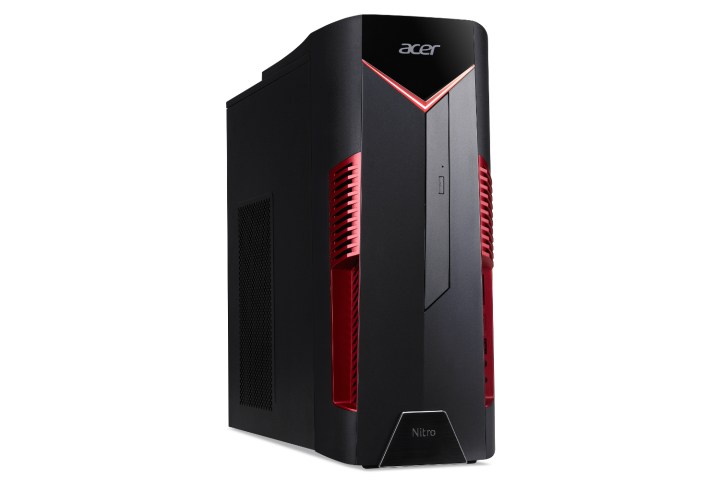
In addition to all the new hardware revealed at the Acer press event last week, the company is introducing three new devices ahead of the Computex show in Taiwan next week. They target gamers using the latest CPUs and graphics from AMD, a nice change from the flood of Intel/Nvidia devices currently dominating the PC market.
Unfortunately, due to their ship dates, we don’t have a specific list of hardware specifications for each. Acer’s trio includes the Predator Helios 500 notebook (PH517-61) arriving in August starting at $2,199, and two desktops slated for September: The Predator Orion 5000 (PO5-100) starting at $1,499 and the Nitro 50 (N50-100) starting at $899. If the names sound familiar, Acer introduced the Intel/Nvidia variants last week.
For starters, the Intel/Nvidia version of Acer’s Predator Helios 500 notebook ships in June starting at $1,999. Shown above, the AMD-based version revealed this week arrives two months later packing up to a second-generation AMD Ryzen 7 2700 eight-core processor, and the mobile version of AMD’s Radeon RX Vega 56 discrete graphics chip with 8GB of dedicated video memory (HBM2).
You read that correctly — there is no Ryzen-branded all-in-one chip here. But given the laptop-based environment, you’re not going to see these two chips match the performance seen in desktops due to keeping the overall heat low inside the laptop’s narrow space. Still, this should be good news for AMD’s customers who want a laptop with near-desktop-like performance and don’t want to settle with an all-in-one chip.
Outside the AMD components, the upcoming laptop will sport a 17.3-inch IPS display with a 1,920 x 1,080 resolution at 144Hz, or a 3,840 x 2,160 resolution at 60Hz. The cooling aspect will be handled by two AeroBlade 3D metal fans and five heat pipes pulling the heat away from the CPU and GPU. Sound includes two speakers, a subwoofer, Acer TrueHarmony, Waves MaxxAudio, and Waves Nx head-tracking technologies.

Next, we have the Predator Orion 5000 desktop. It’s not quite as “dedicated” to AMD as the Predator Helios 500 laptop, supporting up to a second-generation AMD Ryzen 7 2700X processor, and up to two Nvidia GeForce GTX 1080 graphics cards in SLI mode. Unfortunately, the details regarding this desktop are rather scarce for now, but Acer says it will have two EMI-compliant transparent side panels and rely on Acer’s IceTunnel 2.0 airflow management design.
“Easy-open side panels allow users to quickly swap out components and cables during upgrades,” Acer says. “The IceTunnel 2.0 airflow management design segments the system into different thermal zones and provides each sector with its own airflow tunnel to expel heat.”

Finally, we have the Nitro 50 desktop supporting up to a second-generation AMD Ryzen 7 2700X processor. On the graphics front, configurations will include up to an AMD Radeon RX 580 graphics card or go with Team Green and select up to a GeForce GTX 1060 graphics card (6GB).
Backing all of this is storage supporting up to 512GB on a solid-state drive, and up to 3TB on a hard drive. Other features include a wireless charging deck for Qi-enabled devices, an “edgy armored-inspired” chassis with front-facing LED lighting, and Realtek Dragon wired networking.
Editors' Recommendations
- AMD RX 7000 graphics cards are launching in 2022 to challenge Nvidia
- Acer’s updated Predator Helios 300 now comes with RTX 3080 graphics



